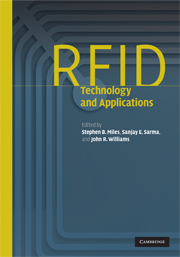Book contents
- Frontmatter
- Contents
- List of contributors
- Preface
- Acknowledgments
- 1 Introduction to RFID history and markets
- 2 RFID technology and its applications
- 3 RFID tag performance optimization: a chip perspective
- 4 Resolution and integration of HF and UHF
- 5 Integrating sensors and actuators into RFID tags
- 6 Performance evaluation of WiFi RFID localization technologies
- 7 Modeling supply chain network traffic
- 8 Deployment considerations for active RFID systems
- 9 RFID in the retail supply chain: issues and opportunities
- 10 Reducing barriers to ID system adoption in the aerospace industry: the aerospace ID technologies program
- 11 The cold chain
- 12 The application of RFID as anti-counterfeiting technique: issues and opportunities
- 13 Closing product information loops with product-embedded information devices: RFID technology and applications, models and metrics
- 14 Moving from RFID to autonomous cooperating logistic processes
- 15 Conclusions
- Appendix – links to RFID technology and applications resources
- Editor biographies
- Index
- References
13 - Closing product information loops with product-embedded information devices: RFID technology and applications, models and metrics
Published online by Cambridge University Press: 02 November 2009
- Frontmatter
- Contents
- List of contributors
- Preface
- Acknowledgments
- 1 Introduction to RFID history and markets
- 2 RFID technology and its applications
- 3 RFID tag performance optimization: a chip perspective
- 4 Resolution and integration of HF and UHF
- 5 Integrating sensors and actuators into RFID tags
- 6 Performance evaluation of WiFi RFID localization technologies
- 7 Modeling supply chain network traffic
- 8 Deployment considerations for active RFID systems
- 9 RFID in the retail supply chain: issues and opportunities
- 10 Reducing barriers to ID system adoption in the aerospace industry: the aerospace ID technologies program
- 11 The cold chain
- 12 The application of RFID as anti-counterfeiting technique: issues and opportunities
- 13 Closing product information loops with product-embedded information devices: RFID technology and applications, models and metrics
- 14 Moving from RFID to autonomous cooperating logistic processes
- 15 Conclusions
- Appendix – links to RFID technology and applications resources
- Editor biographies
- Index
- References
Summary
As companies seek to control their brands and products across ever-expanding global supply chains, further visibility can be extended beyond the point of sale to the points of use across the product lifecycle. Closed-loop product lifecycle management (closed-loop PLM) focuses on tracking and managing the information of the whole product lifecycle, with possible feedback of information to product lifecycle phases. Implementing the PLM system requires a high level of coordination and integration of the product-embedded information devices (PEIDs) that track the products. To fulfill this need, the concept of closed-loop PLM, its system architecture, modeling framework, and metrics have been addressed.
Introduction: closing the product information loop
From a product lifecycle management perspective, a product's lifecycle can be separated into the following main phases: beginning of life (BOL), including design and production: middle of life (MOL), including use, service, and maintenance: and end of life (EOL), characterized by various scenarios such as reuse of the product with refurbishing, reuse of components with disassembly and refurbishing, material reclamation without disassembly, material reclamation with disassembly, and, finally, disposal with or without incineration.
We may say that between the first two phases, i.e. design and production, the information flow is quite complete and supported by intelligent systems such as CAD/CAM, product data management (PDM), and knowledge management systems that are effectively and efficiently used by the industry. However, the information flow becomes less and less complete from the MOL phase to the final EOL scenario.
Information
- Type
- Chapter
- Information
- RFID Technology and Applications , pp. 169 - 182Publisher: Cambridge University PressPrint publication year: 2008
References
Accessibility standard: Unknown
Why this information is here
This section outlines the accessibility features of this content - including support for screen readers, full keyboard navigation and high-contrast display options. This may not be relevant for you.Accessibility Information
- 3
- Cited by
